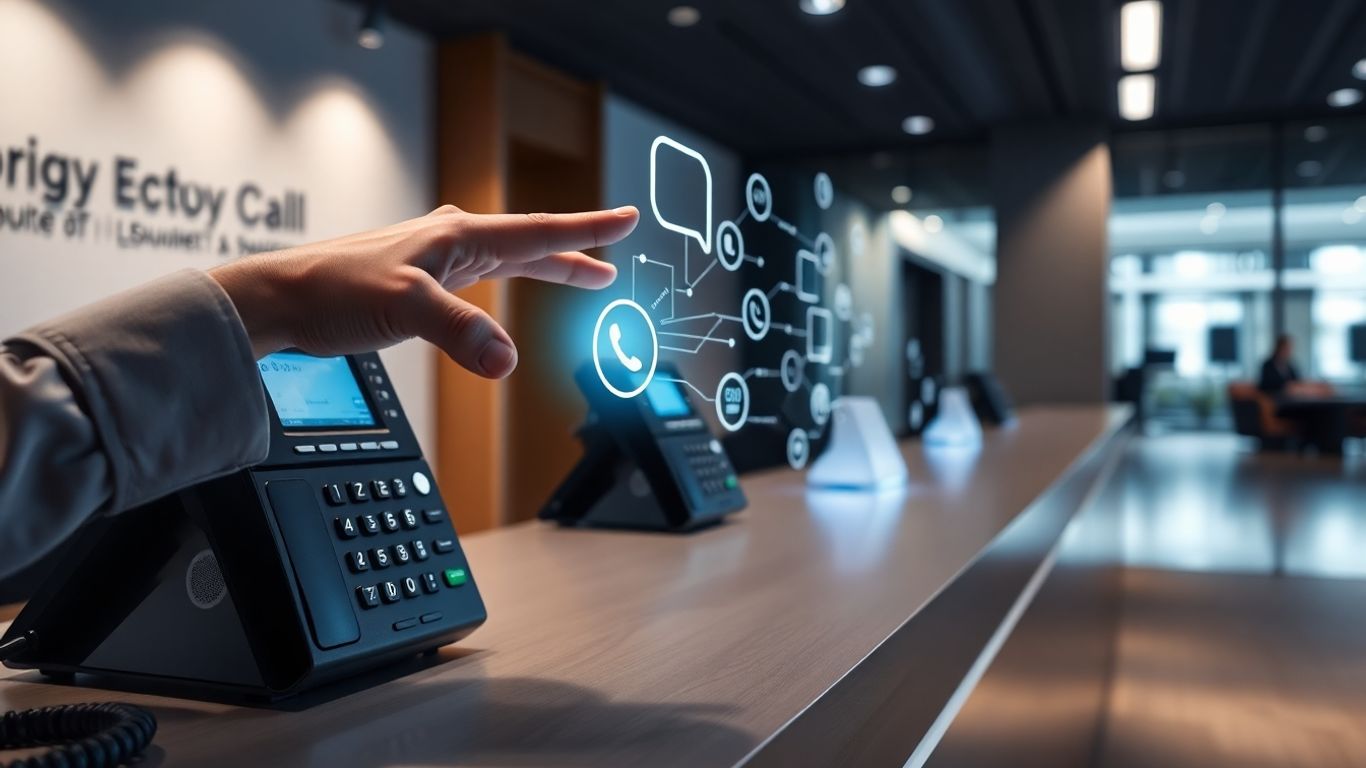Managing phone calls can get pretty hectic, right? You've got people calling in, and you need to make sure they get to the right place without a lot of fuss. That's where an auto phone attendant comes in handy. Think of it as your digital receptionist, ready to guide callers so your team can focus on what they do best. It’s all about making things smoother and quicker for everyone involved.
Dealing with a constant stream of phone calls can feel like juggling chainsaws sometimes, right? You want to make sure every caller gets the attention they deserve, but your team is already swamped. That's where an auto phone attendant system steps in, acting like a super-efficient virtual receptionist. It's not just about answering the phone; it's about making sure the right person or department gets that call without a hitch.
At its heart, an auto attendant is designed to greet callers and then guide them to where they need to go. Think of it as a smart traffic director for your phone lines. Instead of a human receptionist having to manually route every single call, the system presents callers with options, usually through a simple menu. They might press a number or say a word to indicate if they're looking for sales, support, or billing. This simple act of self-service dramatically cuts down on wasted time for both the caller and your staff. It means fewer dropped calls and a smoother experience for everyone involved.
Automating call routing brings a bunch of good things to the table. For starters, it means your callers don't have to sit on hold listening to elevator music while someone tries to figure out who can help them. They get directed quickly, which usually means they're happier. Plus, your team doesn't have to spend their day transferring calls; they can focus on the actual work that needs doing. This kind of efficiency can really add up. Businesses often see a significant reduction in how long calls take overall, sometimes by as much as 30%.
Here are a few key benefits:
Implementing an auto attendant isn't just about saving a few minutes here and there. It's about fundamentally changing how your business communicates, making it more responsive and professional. It's a foundational piece for good customer service.
When calls are handled efficiently, customers notice. They feel like their time is respected. Imagine calling a company and being connected to the right person in seconds, rather than being bounced around. That positive first impression can make a big difference. It shows you're organized and that you care about their needs. This kind of smooth interaction can lead to higher customer satisfaction, and honestly, who doesn't want that? It's a simple way to build better relationships with the people who keep your business running. You can even integrate these systems with your CRM tools to pull up caller information automatically, making the interaction even more personal.

So, what exactly makes an auto phone attendant system so useful? It's not just about answering the phone; it's about doing it smartly. Think of it as your business's digital doorman, greeting everyone and pointing them in the right direction.
First impressions matter, right? This system lets you craft a personal welcome for anyone who calls. You can record your own greeting, so it sounds like you, not some generic robot. Plus, you can pick the music callers hear while they're waiting. It's a small touch, but it makes a difference in how people feel about your business.
This ability to personalize the initial interaction helps set a positive tone before a caller even speaks to a person. It shows you've put thought into their experience.
This is where things get really smart. Your auto attendant can understand when it's time to act differently. For example, during regular business hours, it can route calls directly to the sales team. But when it's 7 PM or a Sunday, it can automatically switch to sending calls to voicemail or a support queue that's monitored 24/7.
Here's a quick look at how it works:
This means no more missed calls just because your office is closed. Your business stays accessible, even when no one is physically there.
In today's world, your customers might speak all sorts of languages. An auto attendant can help you serve them better by offering options in multiple languages. When someone calls, they can choose their preferred language, making it easier for them to understand the menu and get the help they need. This really shows you care about reaching everyone.
So, you've got this fancy auto phone attendant system, which is great. But how do you make it play nice with all the other tools you're already using? It's not just about answering calls; it's about making those calls work for your business. Think of it like connecting the dots between your phone system and everything else that keeps your company running.
This is where things get really interesting. Imagine a caller rings in, and before your team even picks up, their customer history pops up on their screen. That's what connecting your auto attendant to your CRM (like Salesforce or HubSpot) can do. It means your team isn't starting from scratch with every conversation. They know who's calling, what they've bought before, and maybe even why they're calling now. It makes the interaction feel way more personal and efficient.
And your calendar? Connecting that means the auto attendant can help schedule appointments directly. If someone calls to book a meeting, the system can check availability and slot it right into the right person's calendar. No more back-and-forth emails trying to find a time that works for everyone.
Zapier is like the glue that holds a lot of different apps together. If your auto attendant isn't directly integrated with a specific tool, Zapier can often bridge that gap. You can set up "Zaps" that trigger actions in other apps based on what happens with your calls.
Here are a few ideas:
It's all about making sure information flows smoothly without you having to manually move it around. This saves a ton of time and reduces the chance of errors.
For those who like to get a bit more technical, most modern auto attendant systems come with APIs (Application Programming Interfaces). Think of an API as a way for different software programs to talk to each other directly.
This opens up a whole world of possibilities for custom automation. You could build your own internal tools that interact with the phone system. For example:
Integrating your auto attendant isn't just about plugging it in; it's about making it a central part of your communication strategy. When your phone system talks to your other business tools, you create a more connected, efficient, and responsive operation. It's the difference between a phone system that just answers calls and one that actively helps your business grow.

Let's talk about how automated calls can really speed things up for your business. It's not just about answering the phone; it's about making sure every call serves a purpose without bogging down your team. Think of it as giving your staff superpowers to focus on what really matters.
When your phone lines start ringing off the hook, it can feel like a tidal wave. An auto attendant system is built for exactly these moments. It can manage a huge number of incoming calls simultaneously, directing each one to the right place without anyone having to wait forever. This means fewer dropped calls and happier customers, even during your busiest times. It's like having an extra dozen receptionists, but they never get tired or overwhelmed.
Your team members are valuable, and their time is best spent on complex issues that need a human touch. Automated systems can take care of the routine stuff. Things like answering frequently asked questions, providing business hours, or even guiding callers through simple menu options. This frees up your agents to tackle more challenging customer problems, leading to better problem-solving and less burnout.
Getting a caller to the right person quickly is key. An auto attendant does this by asking a few simple questions or letting callers make selections. Based on these answers, the system intelligently routes the call. This cuts down on transfers and ensures the caller connects with the department or person who can best help them, right from the start. It's about making every interaction count.
Here's a quick look at how automated routing can make a difference:
The real win here is that by automating the simple, repetitive tasks, your human agents can dedicate their full attention to the calls that truly require their unique skills and empathy. This not only boosts individual agent productivity but also improves the overall quality of customer interactions.

Today's auto phone attendants are way more than just fancy digital receptionists. They've gotten pretty smart, actually. We're talking about systems that can handle calls with a speed and intelligence that used to be science fiction.
Ever get a voicemail and just dread listening to it? Modern systems can take that audio message and turn it into text. It's super handy because you can just skim the text to see if it's important. No more scrubbing through long messages to find the key details. This means you can manage your messages much faster and decide what needs your attention right away. It's a real time-saver, especially when you're swamped.
Remember when phone systems would tell you all lines were busy? That's pretty much a thing of the past with advanced auto attendants. These systems can handle a massive number of calls all at once. Seriously, you can give your number out to everyone, put it on billboards, tattoo it on your forehead – the system won't flinch. It's like having a superpower for your phone line, making sure no caller gets a busy signal, no matter how many people are trying to reach you simultaneously. This is a big deal for businesses expecting high call volumes, like those in real estate.
Beyond just answering calls, these systems give you a ton of data. You can see things like how many calls came in, where they went, how long people were on hold, and even get transcripts of conversations. This information is gold for figuring out what's working and what's not. You can spot trends, identify bottlenecks, and make smart decisions to improve your customer service. It's like having a business consultant built right into your phone system, always telling you how to get better.
The speed at which these systems operate is truly remarkable. Response times measured in milliseconds mean that conversations feel natural, not like you're waiting for a robot to process your request. This quickness is key to keeping callers engaged and satisfied.

Managing your phone system's expenses doesn't have to be complicated. An auto phone attendant gives you a lot of control over how much you spend and how the system is used. It's not just about saving money, though that's a big part of it. It's also about making sure your phone system works efficiently without breaking the bank.
This is a really useful feature for keeping a lid on costs. You can set a limit on how many minutes your automated attendant can be active within a certain timeframe, like a day, week, or month. This way, you avoid unexpected charges from calls that go on longer than anticipated or from excessive usage. It's like setting a budget for your phone system's active time. You can also set up what happens when you hit that limit – maybe calls go straight to voicemail or get forwarded to a specific person. This gives you predictable billing and helps you manage your expenses better.
With an auto attendant, you get a much clearer picture of your phone system costs. Instead of variable charges that can surprise you, many systems offer straightforward pricing plans. This makes it easier to budget for your communication expenses. You know what you're paying for, and you can track usage to see where your money is going. This predictability is a huge plus for businesses trying to manage their finances effectively.
An auto attendant helps you use your resources more wisely. By handling routine calls and directing callers efficiently, it frees up your human staff to focus on more complex issues. This means your team is spending their time on tasks that truly require their attention, rather than getting bogged down with simple inquiries. It's about making sure every minute of your team's time is spent in the most productive way possible. Think of it as smart allocation – putting your people and your technology where they'll have the biggest impact.
Making sure every caller gets to the right place without a fuss is a big part of how people see your business. An auto attendant system, when set up right, makes your company sound polished and organized. It’s not just about answering the phone; it’s about making a good first impression every single time.
First impressions count, right? Your auto attendant can greet callers with a custom message that sounds like it's coming from your brand. You can record messages that let people know your hours, special announcements, or even just a friendly hello. After the greeting, callers get a menu of options. Think about what your customers usually call for. Do they need sales? Support? Billing? Setting up clear, simple menu choices helps them get where they need to go quickly. For example:
This kind of clear direction stops callers from getting lost or frustrated. It shows you've thought about their needs.
Not all calls are created equal, and sometimes you need to make sure your most important clients get attention right away. An intelligent auto attendant can identify these priority callers, maybe based on their phone number or a code they enter, and move them to the front of the line. This means VIP customers or those with urgent issues get connected to a live agent much faster. It’s a way to show appreciation and handle critical situations with the speed they deserve. This kind of care can really make a difference in keeping those valuable relationships strong.
Nobody likes dealing with spam calls or people who aren't serious about doing business. An auto attendant can act as a gatekeeper. It can screen incoming calls, identifying and blocking known spam numbers before they even reach your team. Some systems can even ask callers to state their name or reason for calling, which can help filter out unwanted interruptions. This keeps your staff focused on real customer interactions and saves them time from having to deal with bothersome calls. It’s a simple but effective way to maintain a professional environment and boost productivity.
Setting up your auto attendant menus and priority rules takes a bit of planning, but the payoff in caller satisfaction and team efficiency is huge. It’s about making the phone system work for you, not against you.
Getting this right means callers feel heard and valued from the moment they dial in. It’s a smart way to manage your communications and present a professional face to the world. If you're looking for a system that can handle this kind of intelligent routing, you might want to check out an AI-powered outbound phone agent that automates many of these tasks.
These AI systems are seriously fast. We're talking response times measured in milliseconds. That's quick enough to keep up with a normal conversation without making anyone feel like they're talking to a slow robot. Think about it: when you call a business and get a laggy, robotic answer, it's just plain annoying, right? AI attendants get rid of that frustration. They don't just answer fast; they process information and react just as quickly. It's like having a super-smart assistant who's always on the ball.
Because these AI attendants respond so quickly, conversations feel much more natural. They don't just follow a rigid script. They can handle complex questions and nuanced requests without missing a beat. It's a big change from the old touch-tone menus that made you want to hang up. This smooth interaction makes customers feel heard and understood, which is a huge win for customer satisfaction.
AI attendants can process and understand complex questions. They can access information and provide answers or direct the caller appropriately, all in real-time. This means fewer dropped calls, less frustration for callers, and more time for your human staff to focus on the really tricky issues. It's about making sure every caller gets the help they need, quickly and effectively, no matter what they're asking.
The speed at which an AI attendant can process information and respond is a game-changer. It transforms potentially frustrating customer interactions into smooth, efficient conversations. This responsiveness is not just a technical feature; it's a core component of providing excellent customer service in today's fast-paced world.
Here's a quick look at what makes them so responsive:
Getting an auto phone attendant system up and running isn't just about picking a provider and flipping a switch. It takes some thought to make sure it actually helps your business and doesn't just become another confusing hurdle for your customers. Think of it like setting up a new employee – you need to train them, give them the right tools, and make sure they know what to do.
Before you even look at software, you need to map out how calls should move through your system. What are the main reasons people call you? Jot those down. Then, figure out the best way to direct them. Do they need sales? Support? Billing? Each of these might need its own path. It's like drawing a flowchart for every possible caller.
Here's a basic breakdown of how to start:
A well-planned call flow means callers get to the right place faster. This not only makes them happier but also frees up your team to handle more complex issues instead of basic routing.
Once you have your call flow blueprint, it's time to translate that into the actual software. Most systems offer a visual editor, which makes things much easier. You'll be setting up greetings, recording prompts, and defining the rules for where calls go.
This is a super important step that a lot of people skip. You've built it, but does it work? You need to test every single path in your call flow. Have friends or colleagues call in and try to reach different departments. See if the routing is correct and if the prompts are clear.
As your business picks up steam, the last thing you want is your phone system becoming a bottleneck. That's where auto phone attendants really shine. They're built to grow right alongside you, no matter if you're just starting out or you've become a big player in your industry.
Think about it: when you get more customers, you get more calls. A human receptionist can only handle so much before things get chaotic. An auto attendant, though? It can manage a huge number of calls all at once. This means you don't have to scramble to hire more people just to answer the phone when business booms. The system just handles the increased volume, making sure every caller gets directed properly without long waits. It's like having an extra team of receptionists that never gets tired or overwhelmed.
One of the best parts about these systems is that they don't just work for huge corporations. Small businesses can get a lot of mileage out of them too. You get professional call handling without the hefty price tag of a full-time, in-house receptionist. As you grow, you can often just adjust your plan or add features, rather than needing a whole new setup. This makes it a really smart financial choice for businesses at any stage.
Customers don't always call during your business hours, right? An auto attendant means your business is always 'open' for basic inquiries and routing. Even when your office is closed, callers can still get information, leave messages, or be directed to an on-call person if needed. This constant availability is a huge plus for customer satisfaction and makes sure you don't miss out on potential business just because it's after 5 PM.
The ability of an auto attendant to scale means your communication infrastructure can keep pace with your business ambitions. It removes the worry of outgrowing your phone system, allowing you to focus on other areas of growth and development.
As your business grows, managing calls can become a challenge. Auto phone attendants are a smart way to handle more calls without missing a beat. They can direct callers to the right place and even answer common questions, freeing up your team. Ready to see how this can help your company expand? Visit our website to learn more!
So, there you have it. Setting up an auto phone attendant system might seem like a big step, but honestly, it's pretty straightforward once you get the hang of it. It really helps sort out calls so you're not bogged down with every little thing. Plus, customers get where they need to go faster, which is always a good thing. It's a smart move for any business that wants to handle calls better and keep people happy without adding a ton of extra work.
Think of it like a helpful robot for your phone. When someone calls your business, this system answers first. It then asks callers what they need and directs them to the right person or department, kind of like a human receptionist but automated.
It's all about speed and not wasting time. Instead of someone having to answer every single call and figure out where it goes, the system does it instantly. This means callers get to the right place faster, and your staff can focus on their main jobs.
Yes! That's one of its best features. When many people call at the same time, the system doesn't get overwhelmed. It can handle many calls all at once, so no one has to wait too long on hold.
Not at all! Modern systems can be set up with friendly greetings and even play music while people wait. You can make it sound just like your business – professional and welcoming.
Many systems can! If you have customers who speak different languages, you can set up the system to offer options in those languages, making it easier for everyone to get help.
These systems can actually save you money. You might need fewer people to answer phones, and you can often set limits on how much it's used to control costs. Plus, it works 24/7 without needing breaks.
Absolutely. Many systems can link up with things like your customer list (CRM) or your calendar. This means when a call comes in, the system might already know who's calling or can automatically add appointments.
Most systems are designed to be easy to set up, often taking just a few minutes. You can usually change greetings, add options, and manage how calls are routed without needing to be a tech expert.
Start your free trial for My AI Front Desk today, it takes minutes to setup!








